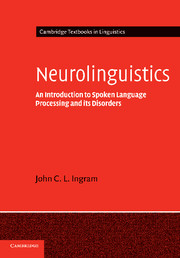Book contents
- Frontmatter
- Contents
- List of figures
- List of tables
- Preface and acknowledgements
- Note on the text
- Part I Foundational concepts and issues
- 1 Introduction and overview
- 2 Aspects of linguistic competence
- 3 The neuroanatomy of language
- 4 On modularity and method
- Part II Speech perception and auditory processing
- Part III Lexical semantics
- Part IV Sentence comprehension
- Part V Discourse: language comprehension in context
- Glossary
- References
- Index
2 - Aspects of linguistic competence
Published online by Cambridge University Press: 26 January 2010
- Frontmatter
- Contents
- List of figures
- List of tables
- Preface and acknowledgements
- Note on the text
- Part I Foundational concepts and issues
- 1 Introduction and overview
- 2 Aspects of linguistic competence
- 3 The neuroanatomy of language
- 4 On modularity and method
- Part II Speech perception and auditory processing
- Part III Lexical semantics
- Part IV Sentence comprehension
- Part V Discourse: language comprehension in context
- Glossary
- References
- Index
Summary
Introduction
In the previous chapter, we described language as ‘the most complex of human artefacts’. In this chapter we shall flesh out this claim with an overview of the major components of the linguistic system from the perspective of the linguist. Broadly speaking, any language may be viewed from three complementary perspectives: (a) as an internalized body of ‘tacit’ knowledge, (b) as a social construction or set of conventions shared by a language community or (c) as a natural object ‘out there’ in the external world (the ‘E-language’). The internal view of language (or ‘I-language’, as it is sometimes referred to by Chomskian linguistics) is clearly the most relevant perspective for the concerns of this book. The I-language consists of the personal knowledge base that each speaker of the language carries around in his/her head as to how meanings or intentions may be encoded in linguistic expressions. Language users rely on their I-language to interpret or decode other speakers' linguistic expressions and to encode their own meanings in the expressions that they produce. The I-language is usually thought of as a personal dictionary of word meanings and rules for utterance construction; an internal grammar, which we know how to use but cannot easily describe.
Because each speaker acquires language under unique circumstances, I-language grammars may vary somewhat from one speaker to another, in ways that are probably mostly inconsequential for communication between members of a speech community.
- Type
- Chapter
- Information
- NeurolinguisticsAn Introduction to Spoken Language Processing and its Disorders, pp. 15 - 39Publisher: Cambridge University PressPrint publication year: 2007

